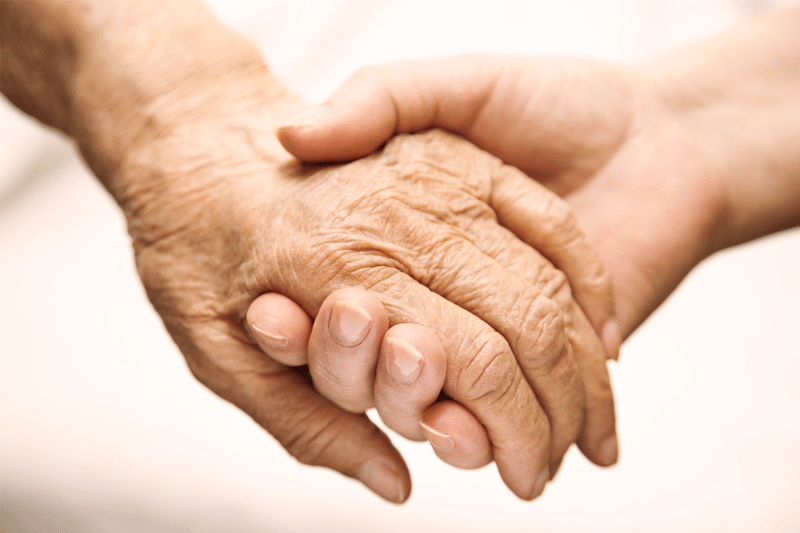Terminal agitation affects many people who are nearing the end of their lives. Also called terminal restlessness, excited delirium, terminal delirium or end-stage restlessness, for otherwise eligible patients, this symptom is often treated in hospice care.
[callout 1]
Symptoms of Terminal Restlessness
The signs of excited delirium, or terminal restlessness, differ from one person to the next. Unusual behaviors can surface suddenly and unpredictably. You may find your typically lethargic loved one trying to stand up, get out of bed or change position. They may tug at their clothes or bedding. They may not recognize you or suddenly see you or others as an enemy. They may demand that you take them to the emergency room or call the police, even if there’s nothing that can be done for them. They may yell at you using language you’ve never heard from them before.
Terminal agitation is more intense than a mood swing or feelings of sadness or anger that often arise as a person nears death. Terminal restlessness is often characterized by:
- Agitation (fidgeting, pacing, twitching, tossing and turning)
- Anxiety, fear or panic
- Angry outbursts, aggression or irrational accusations of wrongdoing
- Difficulty making decisions, such as asking for an item and then rejecting it
- Unsettled behavior, such as pulling at clothes, bedsheets or intravenous (IV) lines
- Depression
- Irritability
- Moaning or crying out
- Disorientation or difficulty paying attention
- Hallucinations or paranoia
- Mental decline, confusion or dementia
Terminal Restlessness vs. Excited Delirium
What is excited delirium? Delirium is a medical condition that may result from several potential causes, including infection, uncontrolled pain and constipation. Delirium is classified as hyperactive, hypoactive or mixed, based on patient symptoms. It occurs in up to 50% of the hospitalized elderly, particularly those with prior cognitive difficulties and those receiving intensive care or palliative care. The symptoms of excited delirium present as a disturbance in attention, consciousness, and cognition, with the most common signs including:
- Anxiety
- Depression
- Lack of interest or emotion
- Poor memory
- Trouble focusing
- Changes in sleep habits
- Poor memory
Terminal Restlessness vs. Terminal Anguish
Agitated delirium is different from terminal anguish, which is emotional distress related to longstanding psychological or spiritual conflicts. The symptoms can be similar, such as restlessness, moaning or crying out, but guilt often plays a role. Spiritual counseling and social work services can help with terminal anguish, especially if the patient receives care before they become too disabled to address the issues.
Causes of Terminal Agitation
If your loved one shows signs of terminal agitation, it is important to get an evaluation. Sometimes there is an underlying cause that can be treated, which alleviates terminal restlessness. It can also be caused by physiological changes happening in the body during the dying process. For example, organs and body systems begin to fail as death nears. The kidneys, liver and other organs stop functioning properly, which can lead to a buildup of waste products or imbalance of chemicals.
So, what causes terminal agitation? Here are some possibilities:
- Uncontrolled pain
- Certain medications, such as pain-relieving opioids, steroids, anti-seizure medication or chemotherapy medications
- A recent change in medication
- Fever, which may be a sign of an infection or other health issue
- Medical issues such as dehydration or anemia
- Sudden change in function
- Emotional issues, such as fear, anxiety, depression or guilt, as patients try to cope with terminal illness and end-of-life
- Inadequate oxygen to the brain (often caused by heart or lung failure), brain swelling or brain tumors
- Chemical imbalance, often caused by organs shutting down at end of life
- Excessive calcium
- Constipation or urinary retention, arising from changes in muscle movements and ability to detect bodily sensations that control these functions
How Long Does Terminal Agitation Last Before Death?
One of the first questions family members ask when they see a loved one suffering is, “How long does terminal restlessness last?” The terminal restlessness duration varies for each individual. Sometimes, it appears briefly and then resolves on its own. It often occurs in the early stages of dying, which usually lasts two weeks (with many exceptions). Many people experience other end-of-life symptoms at the same time, such as tiredness and decreased food and water intake.
How to Help Someone With Terminal Restlessness
Identify Underlying Issues
As a first step, nurses will work with the pharmacist and physician to identify any underlying causes of terminal agitation and treat it, if possible. For example, nurses will evaluate the patient’s discomfort level and use appropriate pain management therapies. They’ll also check vital signs and ask questions to determine if physician’s orders are being followed. If the patient is on hospice, the hospice team coordinates with the patient’s doctor to adjust their care plan and relieve symptoms. In some cases, treating terminal agitation is as simple as repositioning a piece of equipment, such as a catheter, to ease the patient’s discomfort.
Other times, managing terminal restlessness is more complex. If there isn’t an issue that can be treated, care focuses on keeping the patient safe and creating a calm environment. Caregivers and loved ones can monitor the patient closely to prevent them from getting injured. Some patients find music, reading, prayer or gentle massage soothing. Depending on the patient’s illness and needs, their doctor might prescribe medication for terminal agitation.
Be a Calming Presence
In most cases, terminal agitation results from pain or changes in the body and mind. It is unlikely that your loved one’s behavior genuinely reflects how they feel about you. As much as possible, try to respond to a loved one’s terminal agitation with compassion. Talk to them calmly and gently, and try to avoid getting agitated. This isn’t their fault, or yours. It is a common part of the dying process, affecting up to 88% of dying patients.
Get Support
It can be physically and emotionally draining to provide care for a loved one who is dying, especially if they’re experiencing terminal restlessness. They may be difficult to soothe. You may have concerns about their safety. The memory of this disturbed, confused stage may make it difficult to have a meaningful goodbye and grieve.
Just as your loved one needs support, so do you. If your loved one is on hospice, talk to the hospice team for guidance and support. You can also reach out to loved ones, spiritual advisers or trusted friends for relief.
How Hospice Can Help With Terminal Agitation
Hospice providers specialize in addressing end-of-life symptoms like terminal delirium. Here are some of the ways hospice can help:
Social Interventions
- Create a subdued, comforting environment
- Provide a calm, caring presence for the patient and family members
- Reduce isolation
- Give family members the opportunity to leave the bedside for walks or errands
- Connect families to resources in their community
Psychological Interventions
- Provide counseling to families/caregivers
- Relaxation through music, imagery, aromatherapy or gentle massage
- Family education and support
Spiritual Interventions
- Support from a chaplain
- Prayer, reading scripture or spiritual music if comforting to the patient or family
- Finding meaning and purpose in this near-death transition
Physical Interventions
- Medication, as appropriate
Terminal delirium is difficult to manage, but you are not alone. You aren’t expected to know how to respond, and it’s natural to feel upset when a loved one is experiencing terminal agitation. If your loved one is on hospice, your care team can help you keep your loved one as calm and comfortable as possible. Call an Amedisys hospice agency near you to learn more about how hospice can help with terminal restlessness and other end-of-life issues.
Reviewed by Sheena Cupid, MSN, RN, CHPN, Director of Hospice Clinical Staff Development






